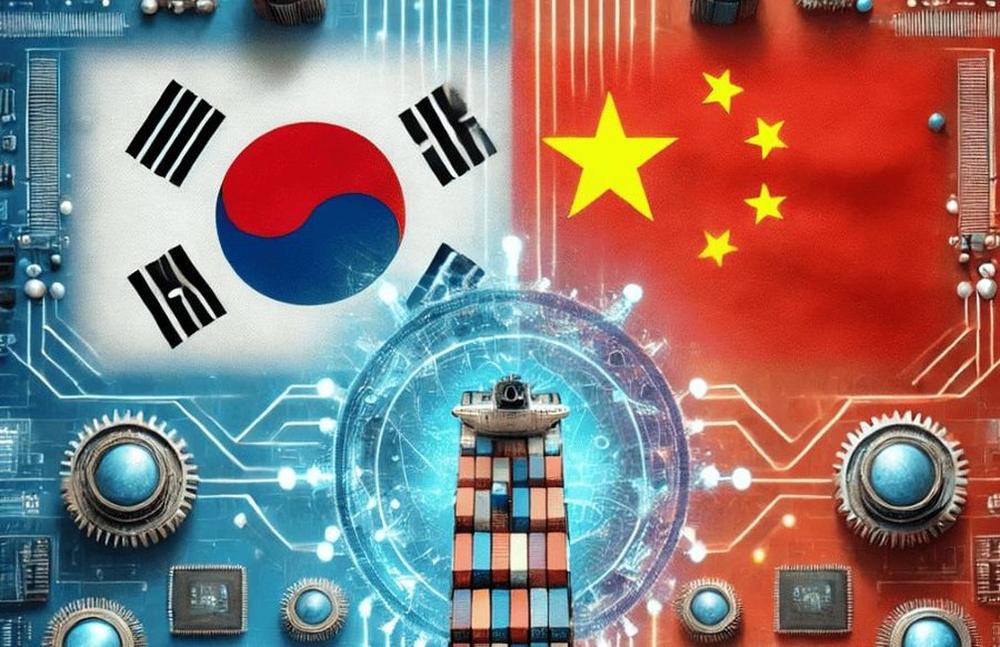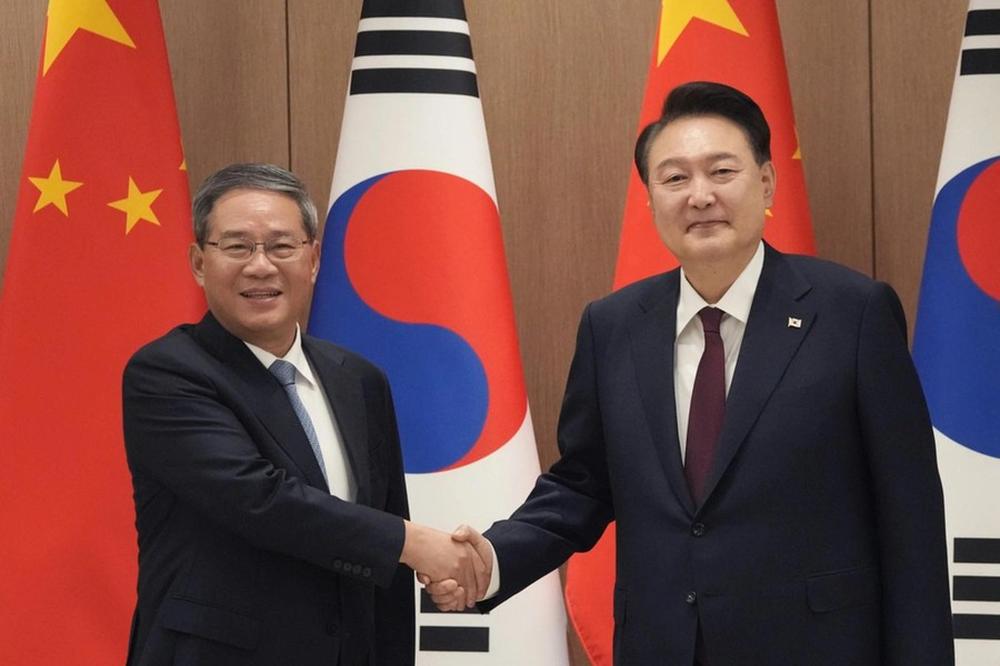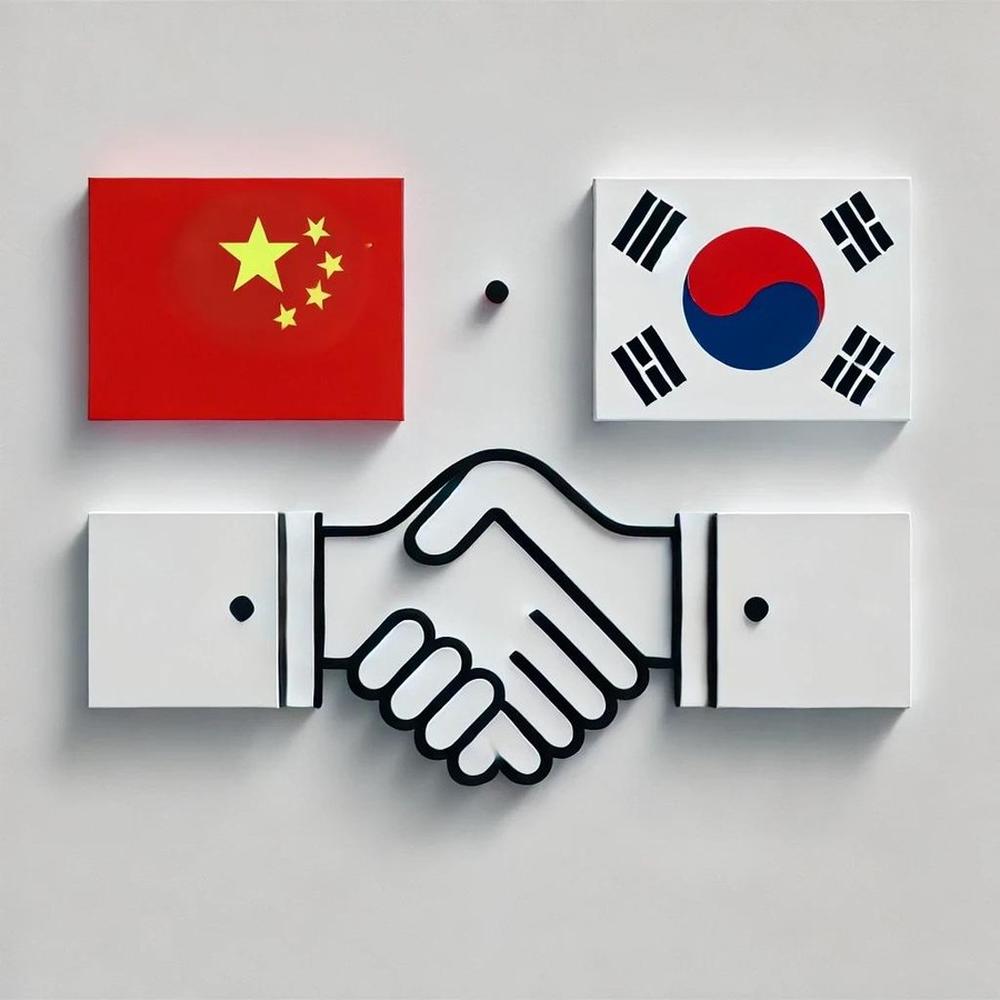
- #China
- #Global Issues
- #South Korea
- #US Foreign Policy

▶️ South Korea-China relations have deteriorated due to economic coercion, security disputes, and trade shifts, including China’s rise as a technological power and its reduced dependence on imports from South Korea. Seoul is struggling to navigate U.S.-China rivalry, which is expected to intensify after Trump returns to the White House.
▶️ In response to economic pressure from both the Trump and Biden administrations, Beijing devalued its currency, engaged in targeted retaliation, bolstered self-reliance, and bent global supply chains. It did not lose ground in the Global South nor come into compliance with international trade norms.
▶️ Rather than pursue destabilizing unilateral policies, Washington and Seoul should prioritize an “alliance first” strategy to address China-related challenges with coordinated burden-sharing and rules-based economic security cooperation.
Relations between the Republic of Korea (ROK, South Korea) and People’s Republic of China (PRC) reached a diplomatic low in 2023 owing to unresolved economic coercion over a missile defense system, lack of coordinated sanctions enforcement on North Korea, air defense identification zone (ADIZ) unannounced entries, exclusive economic zone (EEZ) incursions, and e-commerce data breaches, among other disputes. While PRC-ROK trade volume rebounded after the COVID-19 pandemic, it actually declined by 3.5% from 2022 to 2023, in stark contrast to an average annual growth rate of over 17% from 2001 to 2019. The structure of bilateral trade is changing, with China importing less from South Korea as Chinese firms move up the value chain and increase market share. Meanwhile, South Korean companies looking to safeguard intellectual property and navigate the regulatory environment have shifted investment toward the United States. ROK outbound foreign direct investment (FDI) to the U.S. soared while China fell out of South Korea’s top five FDI destinations in 2023 for the first time since 1992. Also in 2023, Seoul posted a trade deficit with China for the first time since the normalization of diplomatic relations, and in 2024, the U.S. rivaled China as South Korea’s largest export market for the first time since 2003.
Nonetheless, recent developments point to China and South Korea gradually repairing ties. In May 2024, Seoul hosted the long-delayed ROK-Japan-China Trilateral Summit, which sought to revitalize people-to-people exchanges and accelerate trilateral free trade agreement (FTA) negotiations along with implementing the Regional Comprehensive Economic Partnership (RCEP). While bilateral tourism has yet to return to pre-pandemic levels, it has shown considerable recovery. During the first half of 2024, 2.2 million Chinese visitors entered the ROK, and Korean travelers to China are set to increase in light of Beijing’s decision to extend visa-free entry. President Yoon Suk-yeol’s summit with China’s President Xi Jinping on the sidelines of the November 2024 Asia-Pacific Economic Cooperation (APEC) meeting in Peru was their first in-person interaction since a brief introduction on the margins of an ASEAN meeting in Indonesia in 2022. With South Korea set to host the autumn 2025 APEC summit in Gyeongju, Korean diplomats are expecting Xi’s visit to practically and symbolically mark the full restoration of bilateral relations.
However, the more proximate political shift that hung over both the November 2024 APEC and G20 summits was the U.S. presidential election outcome, with governments anticipating significant changes in policy when Donald Trump returns to the White House in January 2025. South Korea’s domestic politics also became a rising factor of uncertainty, especially after Yoon’s aborted attempt to implement martial law led to his impeachment in December. South Korea’s democratic credentials may be damaged, but most U.S. democratic allies were already preparing for less values diplomacy and a more transactional foreign policy from Washington. South Korea’s central bank chief went as far as to claim that Trump’s trade policies pose a greater risk to the economy than domestic political turmoil. This article focuses on Trump’s economic approach toward China, examines Beijing’s responses to the first Trump and Joseph Biden administrations, and concludes with implications for South Korea’s economic security and cooperation with the United States.
Trump’s Negotiating Positions Regarding China
Assessing possible U.S. approaches toward Beijing involves revisiting Trump’s first-term China policies, including tariffs, trade negotiations, and Trump’s personal relations with Xi. From the start of his presidency, Trump emphasized reducing U.S. trade deficits and protecting American workers and intellectual property. Following investigations under Section 301 of the U.S. Trade Act, the Trump administration imposed tariffs of 7.5% on goods such as lithium-ion batteries and clothing, and 25% on items including semiconductor and data server components, affecting approximately $370 billion worth of imports from China. In May 2019, the White House added restrictions to prevent American companies from using foreign technologies posing national security risks, targeting Huawei in particular. In August, the U.S. Treasury Department designated China as a currency manipulator. Although there were frequent gaps between Trump’s promised trade measures and what the government actually implemented, trade war tariffs generated at least $89 billion during his first administration.
In 2020, Washington and Beijing reached the so-called “Phase One Agreement” to avoid further tariff increases in exchange for China promising to eliminate technology transfer requirements and other unfair trade practices. However, implementation was incomplete, including on intellectual property protections and Beijing’s commitments to purchase American goods. In terms of presidential diplomacy, while Trump at times praised Xi as a strong and capable leader with whom he had good interactions, by the end of Trump’s first term, his administration had many harsh words for China’s role in the pandemic and severely condemned Beijing’s human rights practices.
The Biden administration largely maintained Trump-era tariffs while introducing new export controls on advanced computing chips and semiconductors. This “small yard and high fence” strategy aimed to impede Beijing’s ability to indigenously produce advanced technologies, in order to counter threats including cyber hacking and surveillance, as well as military applications to weapons programs of concern. Moreover, the Biden administration attempted to reshore technology supply chains by dramatically increasing subsidies via the Inflation Reduction Act (IRA) and Creating Helpful Incentives to Produce Semiconductors (CHIPS) and Science Act. It also announced tariff hikes to 25% on certain batteries, 50% on solar cells and semiconductors, and 100% on Chinese electric vehicles (EVs). Despite several meetings between Biden and Xi, including a summit in California that helped stabilize bilateral relations, tensions remained high, not only over technology, but also issues related to espionage, human rights, Ukraine, Taiwan, and North Korea.
After the November 2024 election, the presidential transition team announced personnel appointments that offer clues to how Trump 2.0 may differ from Trump 1.0. Many nominations appear domestically focused on removing “deep state” checks and balances that constrained Trump during his first term. In contrast, Marco Rubio is a relatively mainstream Republican choice for secretary of state. The business backgrounds of Scott Bessent (Treasury Secretary) and Howard Lutnick (Commerce Secretary) point to a more pragmatic rather than ideological approach, with Trump’s focus on stock market performance suggesting Wall Street could act as a brake on the administration’s trade war tendencies. Robert Lighthizer, the architect of Trump’s first-term tariff policies, may not return to government. However, his protégé, Jamieson Greer, is expected to take the U.S. Trade Representative job, and Trump’s appointment of Peter Navarro as senior counselor for trade and manufacturing foreshadows a hawkish policy toward China. Navarro supports high tariffs and other drastic measures in pursuit of economic and financial decoupling.
Trump has already promised to impose sweeping tariffs on products from China on his first day in office. This policy position comports with the Republican campaign platform and is accompanied by calls in Washington to revoke China’s Permanent Normal Trade Relations (PNTR) or Most Favored Nation (MFN) status in the interest of U.S. trade security. Moreover, since his reelection, Trump has threatened tariffs not only over technology (China), trade imbalance (China and other countries), illegal immigration (Mexico), and flow of illegal drugs (Canada and others), but also for efforts to undermine the dollar (China, Russia, and other BRICS countries). This shows how Trump sees punitive measures and access to the U.S. market as leverage and is willing to violate existing agreements and risk trade wars to address American grievances with globalization. Whether Trump fully implements this harder line or uses it as an initial negotiating position according to his “art of the deal” remains to be seen.
Beijing’s Response during the first Trump and Biden Administrations
In response to U.S. tariffs imposed under Trump, China retaliated with its own but more limited tariffs on American goods. For instance, in May 2019, when Washington raised tariffs on $200 billion in Chinese goods from 10% to 25%, Beijing responded with plans to increase tariffs on $60 billion of U.S. exports, largely agricultural products. However, it applied the tariff hikes to only two-thirds of the products listed, with levies on half of these products rising only to 10%. Rather than direct retaliation, Beijing often coped with U.S. tariffs by devaluing the Chinese currency (RMB) so that exports from China looked relatively cheaper to consumers abroad.
After the Biden administration reinforced Trump-era technology restrictions, the Chinese Communist Party (CCP) introduced retaliatory tariffs and banned exports to the U.S. of certain critical minerals, marking one of its most stringent countermeasures to date. Instead of scaling back its unfair trade practices, China exploited U.S. delays in implementing export restrictions to stockpile inputs before doubling down on self-reliance, adding to existing initiatives such as “Made in China 2025.” China also redirected some of its exports to the U.S. through intermediary countries such as Vietnam, adjusting supply chains to maintain access to the U.S. market. In efforts at “de-risking,” U.S. companies shifted business and sourced components outside China. But as observed in Southeast Asia’s increasing imports from China and exports to the U.S., this has so far involved bending supply chains more than actual U.S.-China decoupling.
Additionally, Beijing strategically lowered tariffs for other trading partners, mitigating financial losses from the trade war while deepening the Global South’s dependence on China. Enabled by subsidies, China continues to violate World Trade Organization (WTO) rules and engage in dumping, calling into question the effectiveness of U.S. policies in curbing such norm-violating behavior. Meanwhile, tariffs have inflicted costs on the U.S. economy and those of allies such as South Korea.
South Korean Economic Security Interests
The intensifying U.S.-China rivalry places growing pressure on South Korea to diversify industrial supply chains and relocate high-end technologies, advanced chips, and sensitive industries out of China. Policymakers in Seoul are concerned that great power competition will make it difficult for South Korean businesses to keep a foot in both economies. While some South Korean companies may temporarily benefit from the setbacks of Chinese competitors, most long-term financial implications of decoupling would be negative.
South Koreans also fear direct economic fallout of U.S. trade policies. Trump tariffs could explicitly target the U.S. trade deficit with the ROK. Korean battery and EV makers are at risk of losing benefits if the Trump administration makes adjustments to the IRA and CHIPS Act. South Koreans also worry about other U.S. regulations. For example, in December 2024, the U.S. Bureau of Industry and Security (BIS) issued a package of export controls targeting China’s semiconductor manufacturing equipment. This revealed South Korea’s exclusion from the BIS License Exception Implemented Export Controls (IEC) list, indicating Seoul’s lack of alignment with rules adopted by the U.S., European countries, Japan, and Australia. While the ROK has cited provisions within its Foreign Trade Act as obstacles to fully implementing certain export controls that target China and Russia, the act was amended in November 2024. Washington is likely to pressure Seoul to further harmonize regulations, including via collective initiatives such as the Chip 4 alliance.
Conclusion: An “Alliance First” Strategy
Despite pressure from both the Trump and Biden administrations, China is yet to come into compliance with international trade norms. If Washington wants to win its technology and trade competition with Beijing, it should not bet on countering China’s illiberalism with tariffs, protectionism, and unilateralism. While the U.S. remains robust and resilient compared to China’s struggling economy, Beijing wields significant strengths, including a population triple that of the U.S. and considerable international influence, especially in the Global South, as the top trading partner for most countries.
Notable U.S. advantages are rules, innovation, and allies. Without rules, private industry and trading partners cannot enjoy a stable business environment conducive for investment. Without openness to competition, reliance on tariffs and regulation would hinder technological and institutional innovation. Coordination among U.S. allies is not only more economically efficient than unilateralism, it also allows partners to compensate for each other’s less strategic tendencies that are often a function of domestic political constraints.
Rather than pursue Trump’s “America first” policies and see South Korea return to a “strategic ambiguity” approach or even turn to populist nationalism under its next administration, Washington and Seoul would benefit from adopting an “alliance first” strategy. Allies have diversified interests and extensive interdependence with China, despite shared concerns about the policies of the CCP. To engage allies effectively, the U.S. should not disregard their priorities nor expect disproportionate burden-sharing in exchange for providing security. Building trust and cooperation requires avoiding short-term shocks and high-stakes negotiating demands that damage relations over the long-term. Meanwhile, South Korea can continue to deepen cooperation via trilateral coordination with Japan and by contributing more to regional and multilateral initiatives. This will enhance Seoul’s ability to manage potential risks during the Trump 2.0 presidency by demonstrating cost-effective increases in collective economic security.

Leif-Eric Easley (Ph.D. in Government, Harvard University) is a Professor at Ewha Womans University in Seoul where he teaches international security and political economics. His research focuses on U.S.-ROK-Japan coordination toward North Korea and China. He participates in Track II diplomacy and is regularly quoted in international media regarding foreign policies in Asia. Yesun Kim (B.A. in International Studies, Ewha Womans University) is a graduate student in Political Science at Seoul National University and an intern at the East Asia Institute. She is the author of an article on “Women’s Rights in North Korea: Reputational Defense or Labor Mobilization?” and has participated in young leader programs including the Maureen Mansfield Trilateral Youth Empowerment Program.


